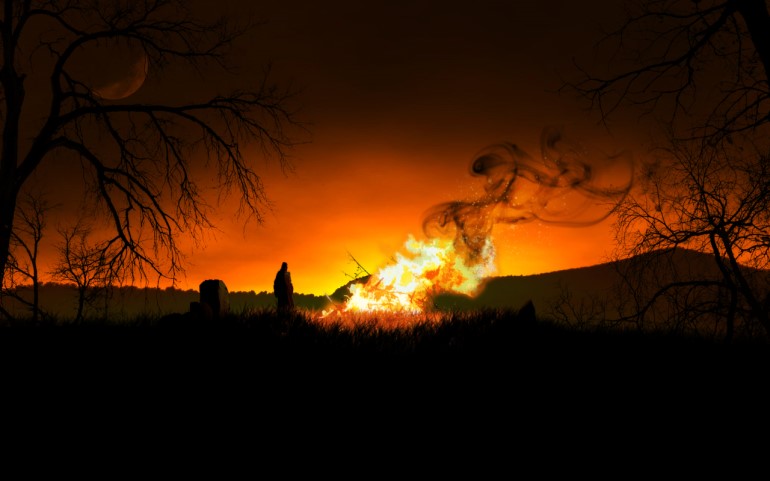Origins and traditions of Samhain

Samhain is a Celtic fire festival, celebrated at the beginning of the Celtic year. It is one of the eight Celtic festivals of the wheel of the Celtic year. Other festivals include winter and summer Solstices, spring and autumn Equinoxes, Imbolc, Bealtaine and Lughnasa. There are four quarter year festivals, two solstices, two equinoxes and four cross quarter festivals. Samhain is a cross quarter festival, which is halfway between autumn equinox and winter solstice. According to the Celtic calendar there is a festival approximately every six weeks.
In 601 AD, Pope Gregory I set about Christianising existing pagan festivals, traditions and beliefs . People, at that time, saw divinity in the elements and the universal energetic forces of nature, such as the sun, moon, sky, trees, and rocks. An attempt was made to Christianise these beliefs, traditions and the festival of Samhain, which we now know as Halloween, by introducing the festivals of All Saints Day (to honour those saints without a feast day of their own) and All Souls Day (for people to honour their ancestors and their deceased loved ones in a Christian context) at the same time of year. Both traditions now co-exist simultaneously.
Samhain and the Otherworld
Samhain, while of Irish origin, is now known internationally as Halloween. However, this Autumn festival originated in Ireland and the beginning of the Celtic new year was celebrated astronomically around 07th November Samhain or Halloween is now celebrated on the 31st October and is traditionally a time for remembering and honouring our ancestors who have passed over to the other world.
At Samhain, it was also believed that the chambers of the fairy sidh spill open, and the vast, uncountable multitudes of fairies have free passage on earth. The very thin veil between this earthly dimension, and the dimensions of those who have died, becomes thinner, heightening psychic sensitivity, communication between the dimensions and allowing our ancestors to return for one night.
Traditions of Samhain
Today, Samhain, or Halloween as it is known is a time for door-to-door “trick or treating”. The practice of wearing masks and dressing in disguise was originally practiced in Celtic pagan times to confuse wandering spirits or fairies. However, the specific practice of “trick-or-treating” is a peculiarly American phenomenon that has become popular in Ireland over the years.

Samhain is a time of seasonal foods, including apples and blackberries, and vegetarian dishes such as Colcannon (associated with the Catholic prohibition of meat on All Saints Day). Pumpkins (traditionally turnips and sugar beet) are carved in long-forgotten commemoration of a supernatural character from a popular folktale whose soul is doomed to wander the earth with a lantern until the end of time. Irish immigrants to the United States found that the pumpkin was much easier to carve than the turnips and sugar beet they had used in their homeland. This Irish tradition adopted by the Americans spread throughout the United States and the world.
Other traditional games include “bobbing for apples or money” and an attempt to reveal the future in messages, such as rings in barmbracks, coins in the mashed potato and cabbage dish known as Colcannon, and apple peels thrown over your shoulder to reveal the first letter of your future spouse’s name. All of these games were part and parcel of Samhain celebrations in most Irish households.
